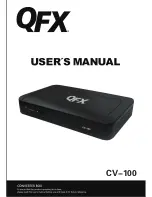
10
www.procontechnology.com.au
Phone: (03) 98306288
CONNECTING AN APPLIANCE AND RUNNING THE INVERTER
•
Connect the appliance AC plug to the inverter AC outlet socket.
•
Switch the inverter
"
ON
"
, the
"
Green
"
power light will illuminate to indicate operation.
•
Turn the appliance
"
ON
"
, if the appliance is fitted with an
"
On/Off
"
switch always
switch the inverter on before switching the appliance on and always turn the
appliance off before switching the inverter off. If necessary, use a power board
with switches.
•
When not in use, turn the inverter off. Leaving the inverter on, even with no AC
load connected, will drain the battery.
TROUBLESHOOTING / FAQ:
Q. Why does the inverter turn itself off?
A. If the red "OVER LOAD" light illuminates this indicates that there is a problem, and
the inverter will usually turn off. Most commonly this would be caused by an
appliance that is drawing too much power and for too high or too low battery voltage.
Note a low input voltage can occur when a voltage drop, due to insufficient sized
cables or batteries. Or when there are poor connections to the input to the inverter.
Initially an audible warning will occur and only after a further drop in battery voltage
does the unit shut down. Operation is restored once the battery voltage returns to
normal. All other "OVER LOAD" faults will cause the inverter to shut down until it is
switched off and on again.
Q. The inverter will not run my appliance even though the appliance label indicates that
it draws less power than the size of the inverter?
A. Electrical appliances can be divided into three groups by the way they draw energy
(current) from their power supply. These groups are "Resistive", "Inductive" and
"Capacitive" appliances or "loads". Some appliances are a combination of these loads.
•
The most common resistive loads are incandescent or filament lights and heating
elements. These devices are non-linear and draw a higher current at start up and,
after a short delay once they “warm up”, they always draw a constant power or
current from the inverter, that is a 100 Watt light will draw approximately 100 Watts
from the power supply at all times. Resistive loads are the easiest load for an inverter
to run provided that it can handle the start-up current. Note a light dimmer with
"
soft
start
"
capability can be used to reduce the start-up current.
•
Inductive loads such as an electric motor require a large rush of power (surge current)
to start and then usually draw a more constant power once running. Inductive loads
contain coils of wire (motors, transformers, ballasts, solenoids) When the power is
first turned on these coils of wire draw a large inrush or surge current which forms the
magnetic flux (magnetic field) which allows these devices to work.
•
The most common inductive appliances are: refrigerators, air conditioners, pumps,
transformers, power tools and fluorescent lights. These appliances can draw 2 - 6
times their normal running power at start up. e.g. to run a 190 Watt refrigerator a 600































